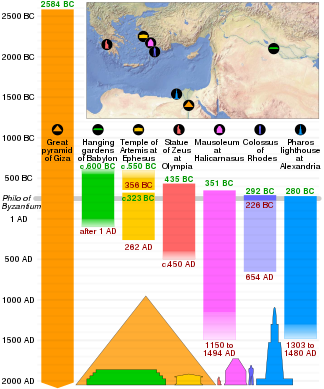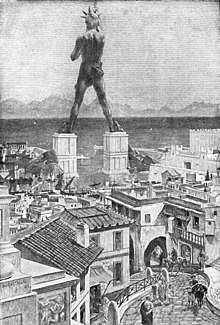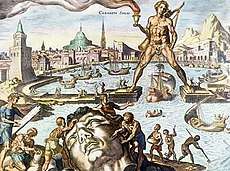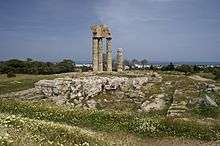Colossus of Rhodes
The Colossus of Rhodes (Ancient Greek: ὁ Κολοσσὸς Ῥόδιος, romanized: ho Kolossòs Rhódios Greek: Κολοσσός της Ρόδου, romanized: Kolossós tes Rhódou)[lower-alpha 1] was a statue of the Greek sun-god Helios, erected in the city of Rhodes, on the Greek island of the same name, by Chares of Lindos in 280 BC. One of the Seven Wonders of the Ancient World, it was constructed to celebrate its successful defense against Demetrius Poliorcetes, who had besieged it for a year with a large army and navy. According to most contemporary descriptions, the Colossus stood approximately 70 cubits, or 33 metres (108 feet) high—the approximate height of the modern Statue of Liberty from feet to crown—making it the tallest statue in the ancient world.[2] It collapsed during the earthquake of 226 BC, although parts of it were preserved. In accordance with a certain oracle, the Rhodians did not build it again.[3] John Malalas wrote that Hadrian in his reign reerected the Colossus,[4] but he was wrong.[5] According to Suda, the Rhodians were called Colossaeans (Κολοσσαεῖς), because they erected the statue on the island.[6]
.jpg)
Since 2008, a series of as-yet-unrealized proposals to build a new Colossus at Rhodes Harbour have been announced, although the actual location of the original monument remains in dispute.[7][8]
Siege of Rhodes
In the late 4th century BC, Rhodes, allied with Ptolemy I of Egypt, prevented a mass invasion staged by their common enemy, Antigonus I Monophthalmus.
In 304 BC a relief force of ships sent by Ptolemy arrived, and Demetrius (son of Antigonus) and his army abandoned the siege, leaving behind most of their siege equipment. To celebrate their victory, the Rhodians sold the equipment left behind for 300 talents[9] and decided to use the money to build a colossal statue of their patron god, Helios. Construction was left to the direction of Chares, a native of Lindos in Rhodes, who had been involved with large-scale statues before. His teacher, the sculptor Lysippos, had constructed a 22-metre-high (72-foot)[10] bronze statue of Zeus at Tarentum.
Construction

Construction began in 292 BC. Ancient accounts, which differ to some degree, describe the structure as being built with iron tie bars to which brass plates were fixed to form the skin. The interior of the structure, which stood on a 15-metre-high (49-foot) white marble pedestal near the Mandraki harbour entrance, was then filled with stone blocks as construction progressed.[11] Other sources place the Colossus on a breakwater in the harbour. According to most contemporary descriptions, the statue itself was about 70 cubits, or 32 metres (105 feet) tall.[12] Much of the iron and bronze was reforged from the various weapons Demetrius's army left behind, and the abandoned second siege tower may have been used for scaffolding around the lower levels during construction. Upper portions were built with the use of a large earthen ramp. During the building, workers would pile mounds of earth on the sides of the colossus. Upon completion all of the earth was removed and the colossus was left to stand alone. After twelve years, in 280 BC, the statue was completed. Preserved in Greek anthologies of poetry is what is believed to be the genuine dedication text for the Colossus.[13]
To you, O Sun, the people of Dorian Rhodes set up this bronze statue reaching to Olympus, when they had pacified the waves of war and crowned their city with the spoils taken from the enemy. Not only over the seas but also on land did they kindle the lovely torch of freedom and independence. For to the descendants of Herakles belongs dominion over sea and land.
Modern engineers have put forward a plausible hypothesis for the statue's construction, based on the technology of the time (which was not based on the modern principles of earthquake engineering), and the accounts of Philo and Pliny, who saw and described the ruins.[14]
The base pedestal was said to be at least 18 metres (59 feet) in diameter, and either circular or octagonal. The feet were carved in stone and covered with thin bronze plates riveted together. Eight forged iron bars set in a radiating horizontal position formed the ankles and turned up to follow the lines of the legs while becoming progressively smaller. Individually cast curved bronze plates 60 inches (1,500 mm) square with turned-in edges were joined together by rivets through holes formed during casting to form a series of rings. The lower plates were one inch (25 mm) in thickness to the knee and 3⁄4-inch (20 mm) thick from knee to abdomen, while the upper plates were 1⁄4–1⁄2-inch (6.5–12.5 mm) thick except where additional strength was required at joints such as the shoulder, neck, etc.
Destruction

The statue stood for 54 years until Rhodes was hit by the 226 BC earthquake, when significant damage was also done to large portions of the city, including the harbour and commercial buildings, which were destroyed.[15] The statue snapped at the knees and fell over onto the land. Ptolemy III offered to pay for the reconstruction of the statue, but the oracle of Delphi made the Rhodians afraid that they had offended Helios, and they declined to rebuild it.
The remains lay on the ground as described by Strabo (xiv.2.5) for over 800 years, and even broken, they were so impressive that many travelled to see them. Pliny the Elder remarked that few people could wrap their arms around the fallen thumb and that each of its fingers was larger than most statues.[16]
In 653, an Arab force under Muslim caliph Muawiyah I captured Rhodes, and according to The Chronicle of Theophanes the Confessor,[17] the statue was melted down and sold to a Jewish merchant of Edessa who loaded the bronze on 900 camels.[18] The Arab destruction and the purported sale to a Jew possibly originated as a powerful metaphor for Nebuchadnezzar's dream of the destruction of a great statue.[19]
The same story is recorded by Bar Hebraeus, writing in Syriac in the 13th century in Edessa:[20] (after the Arab pillage of Rhodes) "And a great number of men hauled on strong ropes which were tied round the brass Colossus which was in the city and pulled it down. And they weighed from it three thousand loads of Corinthian brass, and they sold it to a certain Jew from Emesa" (the Syrian city of Homs). Theophanes is the sole source of this account and all other sources can be traced to him.
Posture
The harbour-straddling Colossus was a figment of medieval imaginations based on the dedication text's mention of "over land and sea" twice and the writings of an Italian visitor who in 1395 noted that local tradition held that the right foot had stood where the church of St John of the Colossus was then located.[21] Many later illustrations show the statue with one foot on either side of the harbour mouth with ships passing under it. References to this conception are also found in literary works. Shakespeare's Cassius in Julius Caesar (I, ii, 136–38) says of Caesar:
Why man, he doth bestride the narrow world
Like a Colossus, and we petty men
Walk under his huge legs and peep about
To find ourselves dishonourable graves
Shakespeare alludes to the Colossus also in Troilus and Cressida (V.5) and in Henry IV, Part 1 (V.1).

"The New Colossus" (1883), a sonnet by Emma Lazarus written on a cast bronze plaque and mounted inside the pedestal of the Statue of Liberty in 1903, contrasts the latter with:
The brazen giant of Greek fame
with conquering limbs astride from land to land
While these fanciful images feed the misconception, the mechanics of the situation reveal that the Colossus could not have straddled the harbour as described in Lemprière's Classical Dictionary. If the completed statue had straddled the harbour, the entire mouth of the harbour would have been effectively closed during the entirety of the construction, and the ancient Rhodians did not have the means to dredge and re-open the harbour after construction. Also, the fallen statue would have blocked the harbour, and since the ancient Rhodians did not have the ability to remove the fallen statue from the harbour, it would not have remained visible on land for the next 800 years, as discussed above. Even neglecting these objections, the statue was made of bronze, and engineering analyses indicate that it could not have been built with its legs apart without collapsing under its own weight.[21] Many researchers have considered alternative positions for the statue which would have made it more feasible for actual construction by the ancients.[21][22] There is also no evidence that the statue held a torch aloft; the records simply say that after completion, the Rhodians kindled the "torch of freedom". A relief in a nearby temple shows Helios standing with one hand shielding his eyes, similar to the way a person shields their eyes when looking toward the sun, and it is quite possible that the colossus was constructed in the same pose. While scholars do not know what the statue looked like, they do have a good idea of what the head and face looked like, as it was of a standard rendering at the time. The head would have had curly hair with evenly spaced spikes of bronze or silver flame radiating, similar to the images found on contemporary Rhodian coins.[21]
Possible locations

While scholars generally agree that anecdotal depictions of the Colossus straddling the harbour's entry point have no historic or scientific basis,[21] the monument's actual location remains a matter of debate.
The floor of the Fortress of St Nicholas, near the harbour entrance, contains a circle of sandstone blocks of unknown origin or purpose. Curved blocks of marble that were incorporated into the Fortress structure, but are considered too intricately cut to have been quarried for that purpose, have been posited as the remnants of a marble base for the Colossus, which would have stood on the sandstone block foundation.[21]

Archaeologist Ursula Vedder postulates that the Colossus was not located in the harbour area at all, but rather was part of the Acropolis of Rhodes, which stood on a hill that overlooks the port area. The ruins of a large temple, traditionally thought to have been dedicated to Apollo, are situated at the highest point of the hill. Vedder believes that the structure would actually have been a Helios sanctuary, and a portion of its enormous stone foundation could have served as the supporting platform for the Colossus.[23]
Modern Colossus projects
In 2008, The Guardian reported that a modern Colossus was to be built at the harbour entrance by German artist Gert Hof leading a Cologne-based team. It was to be a giant light sculpture made partially out of melted-down weapons from around the world. It would cost up to €200 million.[24]
In December 2015, a group of European architects announced plans to build a modern Colossus bestriding two piers at the harbour entrance, despite a preponderance of evidence and scholarly opinion that the original monument could not have stood there.[7][8] The new statue, 150 metres (490 ft) tall (five times the height of the original) would cost an estimated US$283 million, funded by private donations and crowdsourcing.[8] The statue would include a cultural centre, a library, an exhibition hall, and a lighthouse, all powered by solar panels.[8] As of October 2018, no such plans have been carried out and the website for the project is offline.
See also
- Twelve Metal Colossi
- The Colossus of Rhodes (Dalí)
- The Colossus of Rhodes (film)
- The New Colossus
- The Rhodes Colossus
- List of statues by height
References
Notes
- Kolossos means "giant statue". R. S. P. Beekes has suggested a Pre-Greek proto-form *koloky-.[1]
References
- Etymological Dictionary of Greek, Brill, 2009, p. 740. ISBN 9789004174184.
- Higgins, Reynold (1988) "The Colossus of Rhodes" p. 130, in The Seven Wonders of the Ancient World, Peter A. Clayton and Martin Jessop Price (eds.). Psychology Press, ISBN 9780415050364.
- Strabo, Geography, 14.2.5
- Malalas, Chronography Bks 10–11, 11.279
- Boatwright, Mary T. (2002). Hadrian and the Cities of the Roman Empire. Princeton University Press. p. 24. ISBN 978-0691094939.
- Suda, ka.1932
- Williams, Kate (26 December 2015). "Rhodes reconstruction project will be a colossal gamble for Greece – but it might well pay off". Guardian. Retrieved 25 July 2016.
- Bennett, Jay (7 January 2016). "There's a Plan To Rebuild the Colossus of Rhodes". Popular Mechanics. Retrieved 25 July 2016.
- Pliny the Elder, Natural History xxxiv.18.
- Forty cubits high, according to Pliny the Elder (Natural History xxxiv.18).
- Accounts of Philo of Byzantium ca. 150 BC and Pliny (Plineus Caius Secundus) ca. 50 AD based on viewing the broken remains
- https://www.britannica.com/topic/Colossus-of-Rhodes
- Anthologia Graeca 4, 171 H. Beckby (Munich 1957)
- "Engineering Aspects of the Collapse of the Colossus of Rhodes Statue". International Symposium on History of Machines and Mechanisms. Springer. 2004. pp. 69–85. ISBN 978-1-4020-2203-6.
- Bruemmer Bozeman, Adda (1994). Politics and Culture in International History: From the Ancient Near East to the Opening of the Modern Age. Transaction Publishers. p. 108. ISBN 1-56000-735-4.
- Natural History, book 34, xviii, 41.
- See also Constantine VII Porphyrogenitos, De administrando imperio xx–xxi.
- "AM 6145, AD 652/-3". The Chronicle of Theophanes Confessor. Clarendon Press – Oxford. 1997. p. 481.
- Conrad, L.I. (July 1996). "The Arabs and the Colossus". Journal of the Royal Asiatic Society. 6 (2): 165–187. doi:10.1017/S1356186300007173. JSTOR 25183179.
- Budge, E.A. Wallis (1932) The Chronography of Gregory Abu'l-Faraj, Vol. I, p. 98, APA – Philo Press, Amsterdam
- Jordan, Paul (2014). Seven Wonders of the Ancient World. Routledge. pp. 21–149. ISBN 9781317868859.
- "The Colossus of Rhodes". greatest-unsolved-mysteries.com.
- "Koloss von Rhodos: Standort entdeckt! Exklusiv in P.M. HISTORY: Sensationelle Theorie der Münchner – Pressemitteilung Gruner+Jahr, P.M. History". presseportal.de. April 2008. Archived from the original on 2008-05-11.
- Smith, Helena (2008-11-17). "Colossus of Rhodes to be rebuilt as giant light sculpture". The Guardian. Retrieved 2017-12-07.
Sources
- Ashley, James R. (2004). The Macedonian Empire: The Era of Warfare Under Philip II and Alexander the Great, 359-323 B.C. McFarland & Company. p. 75. ISBN 0-7864-1918-0.
- Gabriel, Albert. Bulletin de Correspondance Hellenique 56 (1932), pp. 331–59.
- Haynes, D.E.L. "Philo of Byzantium and the Colossus of Rhodes" The Journal of Hellenic Studies 77.2 (1957), pp. 311–312. A response to Maryon.
- Maryon, Herbert, "The Colossus of Rhodes" in The Journal of Hellenic Studies 76 (1956), pp. 68–86. A sculptor's speculations on the Colossus of Rhodes.
Further reading
| Wikimedia Commons has media related to Colossus of Rhodes. |
| Wikisource has the text of The New Student's Reference Work article "Colossus of Rhodes". |
| Library resources about Colossus of Rhodes |
- Jones, Kenneth R. 2014. "Alcaeus of Messene, Philip V and the Colossus of Rhodes: A Re-Examination of Anth. Pal. 6.171." The Classical Quarterly 64, no. 1: 136–51. doi:10.1017/S0009838813000591.
- Romer, John., and Elizabeth Romer. 1995. The Seven Wonders of the World: A History of the Modern Imagination. 1st American ed. New York: Henry Holt.
- Woods, David. 2016. "On the Alleged Arab Destruction of the Colossus of Rhodes c. 653." Byzantion: Revue Internationale Des Etudes Byzantines 86: 441–51.